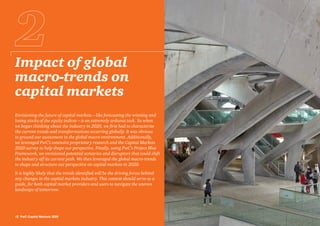The document explores the future of capital markets, emphasizing the need for participants and users to adapt to evolving challenges including regulation, technology, and client expectations as they approach 2020. It highlights the importance of understanding macro-trends and developing strategic priorities to foster innovation and successfully navigate a potentially shrinking capital landscape. Moreover, the survey of capital market executives reveals a consensus on the necessity for improved client relationships, enhanced culture, and the balancing act between risk management and profitability.



























































